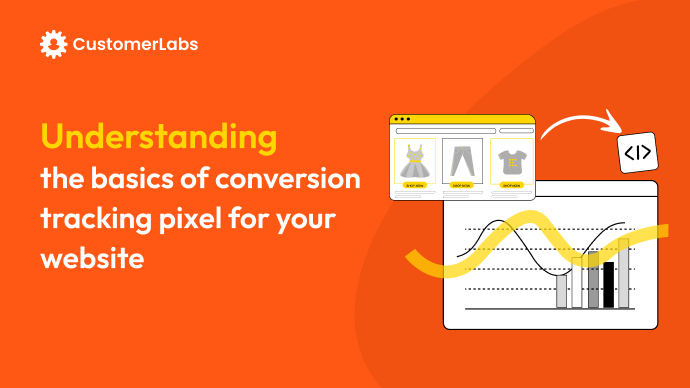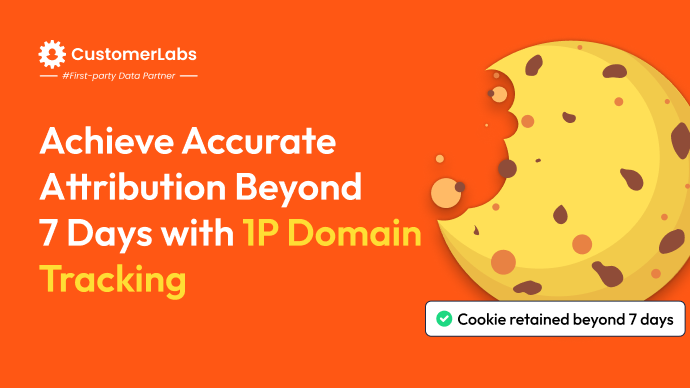Marketing is a lot like cooking. You throw a bunch of ingredients in the pot and hope they come together into something delicious. But how do you know which ingredient (or campaign) made the dish work? This is where a marketing attribution model comes in.
An attribution model helps you understand which marketing touchpoints contribute the most to your conversions. Did your customer click on that Facebook ad first, or did they see a Google search ad later on before making a purchase? An attribution model tells you how much credit to give each step in that journey.
Without one, you’re essentially guessing which campaigns are actually driving sales. And guesswork? It’s not how you scale a successful business.
At CustomerLabs, we help businesses track and analyze customer interactions to build a strong data foundation. A robust attribution model relies on precise, real-time data—something we make possible. Ready to learn how to create an attribution model that works? Let’s dive in!
What is a Marketing Attribution Model ?
In simple terms, marketing attribution is the process of figuring out which marketing activities led to a conversion. Did your customers click on your ad and then make a purchase, or did they visit your website via an organic search before taking action? Attribution models allow you to give the right credit to each marketing touchpoint.
Without an attribution model, you’re flying blind. You might think an email campaign is working wonders when, in reality, it was the social media post a customer saw earlier that had a bigger impact. Attribution helps you identify those key touchpoints so you can focus your energy (and budget) on the ones that really matter.
With robust 1PD Ops tools like Customerlabs, you can track and analyze customer journeys across multiple touchpoints, giving you the clarity needed to implement an effective attribution strategy.
If you’re not tracking the effectiveness of your campaigns, your marketing efforts could end up being inefficient. Imagine spending all your budget on Facebook ads when the real conversions are coming from your email list. A solid attribution model helps prevent this by giving you a clear picture of what’s driving the most value.
Next, let’s understand the difference between the attribution models out there.
What are the Different Types of Attribution Models
There are several types of attribution models, each with its unique strengths. Here’s a quick breakdown of the most common models:
| Attribution Model | Description | Best For |
| Single-Touch Attribution | Assigns all credit to one touchpoint, either the first or last interaction. | Simple and quick analysis of first or last touch. |
| First-Touch Attribution | All credit is given to the first touchpoint a customer interacts with. | Understanding initial brand exposure. |
| Last-Touch Attribution | All credit is given to the last touchpoint before the conversion. | Identifying the final catalyst for conversions. |
| Multi-Touch Attribution | Distributes credit across multiple touchpoints in the customer journey. | Comprehensive insights into all touchpoints. |
| Linear Attribution | Distributes equal credit to every touchpoint in the customer journey. | Equal weight on each customer interaction. |
| Time-Decay Attribution | Gives more credit to touchpoints closer to the conversion event. | Understanding the importance of recent touchpoints. |
| Position-Based Attribution | Assign a fixed percentage of credit to the first and last touchpoints, with the rest spread out evenly. | Highlighting the importance of both the first and last touch. |
| Algorithmic/Data-Driven Attribution | Uses machine learning and data analytics to assign credit based on actual customer behavior. | Complex customer journeys with multiple touchpoints. |
| Custom Attribution Models | Custom-designed models tailored to the business’s specific touchpoints and goals. | Businesses with unique sales cycles and marketing strategies. |
Choosing the Right Attribution Model
Now, it’s time to pick the attribution model that best fits your needs.
1. Assess Your Business Goals and Customer Journeys
Take a look at your business goals. Are you focusing more on brand awareness or on conversions? Your model should reflect this. If you’re trying to understand the complete customer journey, a multi-touch model might be best.
2. Generalize Your Typical Buying Processes
Think about how your customers typically interact with your brand. Do they go from social media to your website to email before buying? Understanding the typical customer journey can help you choose the right model.
3. Experiment with Multiple Models
Don’t be afraid to experiment. Try a first-touch model for some campaigns and a time-decay model for others. See which gives you the most accurate results.
4. Consider Your Business Model, Marketing Strategy, and Budget
Your business model and available budget will also affect your choice. Larger budgets with more complex funnels might benefit from a custom or algorithmic model, while smaller businesses might stick with something simpler.
At CustomerLabs 1PD Ops, we help businesses experiment and fine-tune their attribution models based on real customer data. Start optimizing your attribution today!
Now that you’ve picked the right attribution model, let’s talk about setting up one that’s tailored to your business.
Steps to Build a Custom Marketing Attribution Model
Pre-made attribution models are helpful, but they don’t always capture the unique way your business runs. Creating a custom model gives you more control and ensures you’re tracking what really matters. Whether it’s tweaking weights or focusing on specific touchpoints, a custom model helps you get insights that actually drive decisions. Here’s how to build one that works for you.
To gain better control over how your marketing channels impact conversions, here’s how you can build a custom attribution model that fits your needs. Follow these step-by-step instructions to create a custom attribution model using the Attribution Modeling Tool:
- Go to the Attribution Tab:
In your reporting section, click on the Attribution tab. - Access the Attribution Modeling Tool:
From the left-hand navigation, click on Attribution Modeling Tool. - Choose a Floodlight Configuration:
Select the appropriate Floodlight configuration for your model. - Create a New Custom Model:
- Click on the first available attribution model.
- Scroll to the bottom of the model list and click Create new custom model.
- If you’ve already created custom models, you can also edit or copy them to make new ones.
- Name Your Custom Model:
Enter a name for your new custom attribution model. - Choose a Baseline Model:
Pick a baseline model for your custom attribution model. Your customization options will depend on which baseline model you choose. For instance, if you select Time Decay, you can adjust the half-life. - Enable Customization:
For each area you want to modify, toggle the setting from Off to On to unlock the customization options. - Save and Apply:
Once you’re done with customization, click Save and Apply. This custom model will be applied to your current setup and saved to the Floodlight configuration, so you can reuse it whenever needed.
With these steps, you’ve created a custom attribution model for better control over your conversion tracking.
To streamline the collection and centralization of customer data, CustomerLabs offers a platform that integrates multiple data sources in real-time, so you can easily track and analyze customer journeys.
What are the Available Customizations?
Depending on the baseline model you choose, you’ll have access to different customization options. Here’s what you can tweak:
Lookback Window
This lets you adjust how far back the model looks to give credit for interactions with your ads. Keep in mind, you can only shorten the lookback window for this attribution model, not extend it. If the floodlight activity lookback window is already in place, it’ll take priority.
Adjust Credit by Interaction Type
You can decide how much credit to give impressions compared to other interactions in the conversion path. For example, you might want to assign less credit to impressions by using a decimal value under 1, or give more credit to impressions that happen just before a click, like setting a higher multiplier for impressions within two minutes of a click.
For Twitter measurement beta users, you can also set custom weightings for social engagements—giving more value to high-value engagements (like shares and retweets) and less to low-value ones (like profile views or expands). This doesn’t apply to First Interaction and Last Interaction models, though, since these models assign all credit to one single interaction.
Apply Custom Credit Rules
Create custom rules to assign credit based on specific criteria. For example, you can assign more credit to interactions that match a paid search keyword. If you set multiple rules for the same touchpoint, the credit for each rule is multiplied. For instance, if one rule gives 0.2 credit and another gives 3 credit, an interaction that matches both gets 0.6 credit (0.2 × 3).
Note that First Interaction and Last Interaction models only allow one custom rule since they give all credit to one interaction.
Set Half-Life of Decay
If you’re using the Time Decay model, you can adjust the half-life. This means an interaction that happens a set number of days before the conversion gets half the credit compared to an interaction that happens the same day as the conversion.
Specify Conversion Credit Based on Position
For Position Based models, you can set the percentage of credit for the first and last interactions, as well as distribute the rest to the middle interactions. The total must add up to 100%.
These customization options give you control over how credit is assigned across different touchpoints in the conversion path.
Challenges in Attribution Modeling
While attribution models are incredibly valuable for understanding the impact of your marketing campaigns, they’re not without their challenges. Successfully navigating these hurdles requires a keen understanding of both the data and your business. Let’s dive into some common obstacles you might face when building and implementing an attribution model:
1. Correlation vs. Causation
One of the biggest pitfalls in attribution modeling is assuming that correlation equals causation. Just because two events happen in tandem doesn’t necessarily mean one caused the other.
For example, if you notice a spike in sales after launching a social media ad campaign, it’s tempting to conclude that the campaign was the sole driver of the increase. However, other factors—like a holiday sale or an email promotion—might have also contributed to the boost.
Attribution models, especially basic ones, can sometimes over-simplify relationships. They might assign too much credit to a single touchpoint or overlook critical interactions that influenced the final decision. As a result, you may end up making misinformed decisions if you don’t carefully interpret the data.
2. Complexity of Marketing Funnels
Marketing funnels are rarely straightforward, and they become even more complicated when you’re using multiple marketing channels. A potential customer might start their journey with a Google search, then engage with a Facebook ad, download a lead magnet through an email campaign, and finally make a purchase through a remarketing ad. With so many different touchpoints across different platforms, it can be incredibly challenging to trace the exact path a customer took before converting.
This complexity makes it difficult to accurately assign credit to individual touchpoints, especially when customers take multiple actions across different devices or even switch between channels mid-way through their journey. In many cases, you might only be able to capture a part of the story.
3. Limitations of Pre-Built Models
Pre-built attribution models, like first-touch, last-touch, or even multi-touch, are convenient, but they often don’t reflect the unique nuances of your specific business. These models typically follow a one-size-fits-all approach, but not every business has the same sales cycle or customer behavior. For example, a B2B company with a long sales cycle might find that a last-touch model oversimplifies how leads actually convert, while a direct-to-consumer brand may find more value in a time-decay model.
If you rely too heavily on pre-built models, you might miss important details specific to your customer journey. While these models can be a good starting point, they don’t always paint the most accurate picture for your business.
4. Restrictions with First-Party Data
First-party data is the gold standard when it comes to attribution modeling because it comes directly from your customers. However, collecting and using this data isn’t always straightforward. Privacy laws like GDPR and CCPA restrict how you can collect and store data, and some platforms (like social media or certain ad networks) may limit the level of detail you can track.
For example, if you’re unable to collect certain customer data due to privacy restrictions, it may result in gaps in your attribution model. You might not be able to fully trace a customer’s journey or assign proper credit to specific touchpoints, ultimately affecting the accuracy of your model.
Benefits of a Well-Designed Attribution Model
When your attribution model is thoughtfully designed and properly implemented, the results speak for themselves. It can transform the way you approach marketing, enabling smarter decisions and better results—all based on real, actionable data. Here’s how:
1. Improved ROI
Every marketing dollar counts, and a well-designed attribution model ensures you’re putting those dollars where they’ll work hardest. By pinpointing which channels, campaigns, or touchpoints generate the highest returns, you can reallocate your budget to maximize performance. Instead of overspending on underperforming strategies, you’ll have the clarity to double down on the ones that truly matter. Over time, this focused approach translates into better returns and a more efficient use of your resources.
2. Enhanced Insights
Attribution models don’t just tell you where your conversions are coming from; they offer a wealth of information about your customer journeys. You’ll see how customers interact with your brand at different stages of their decision-making process, which helps you identify patterns, preferences, and pain points. These insights are invaluable when it comes to optimizing your campaigns and targeting your audience more effectively.
3. Better Alignment Between Marketing and Sales Teams
One of the biggest challenges businesses face is ensuring their marketing and sales teams are on the same page. A solid attribution model bridges the gap between these departments by providing a shared understanding of what drives conversions. When everyone has access to the same data and insights, it’s easier to collaborate, set realistic goals, and execute strategies that work toward a common objective.
4. Increased Personalization
In today’s marketing landscape, personalization is no longer a luxury—it’s a necessity. A well-designed attribution model provides the granular insights you need to understand individual customer behaviors, preferences, and journeys. Armed with this information, you can create highly personalized campaigns that resonate with your audience and drive stronger engagement.
Keep Testing and Optimizing Your Attribution Model
To wrap it up, building the right attribution model is not a one-time task—it’s an ongoing process. The effectiveness of your marketing efforts depends on your ability to understand which touchpoints contribute the most to customer conversions. A well-designed attribution model gives you the clarity you need to allocate your marketing budget more efficiently, fine-tune your strategies, and boost your overall ROI.
Whether you’re just getting started with attribution or looking to refine an existing model, remember that testing, adjusting, and continuous learning are key. Marketing is dynamic, and so should be your approach to attribution. The beauty of attribution models lies in their flexibility—you can experiment with different approaches, track their success, and refine your strategy over time. Don’t be afraid to iterate and adapt as you gather more data and insights.
At CustomerLabs 1PD Ops, we understand that building a successful attribution model requires more than just basic tracking. Our platform enables businesses to centralize and analyze customer data across multiple touchpoints, giving you the detailed insights you need to optimize your campaigns.
By helping you create and refine your attribution model, we empower you to make smarter, data-driven decisions that directly impact your bottom line. Want to take your marketing strategies to the next level? CustomerLabs can help.
Get started with personalized data analytics today and boost your marketing ROI!





